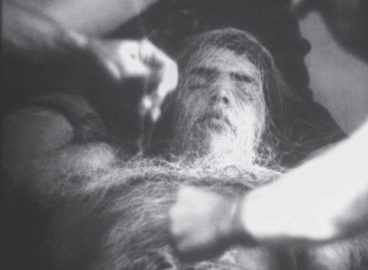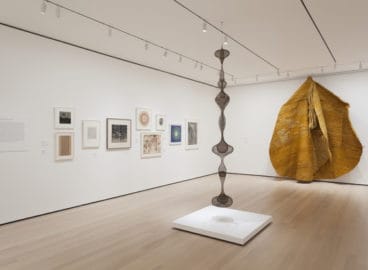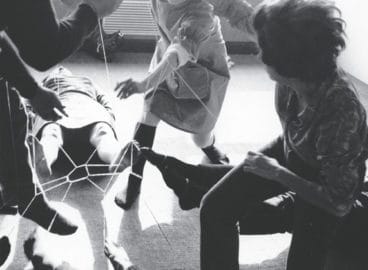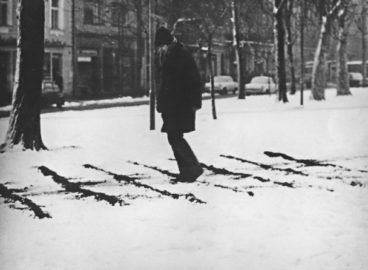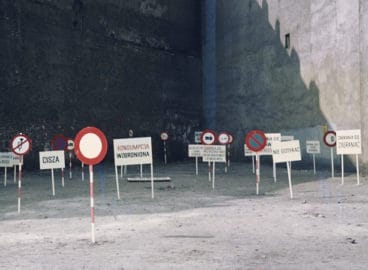Lecture on the Exhibition (In Memory of the Council of Chalcedon)
Miklós Erdély
From the Creed of the Council of Chalcedon: “Following, therefore, the holy fathers, we all teach with one accord one and the same Son, our Lord Jesus Christ, perfect in His Godhead and perfect in His manhood, true God and true man, consisting of a reasonable soul and of a body, of one substance with the Father as touching the Godhead, and of one substance with us as touching the manhood, like unto us in everything, sin excepted, according to the Godhead begotten of the Father before all time, but in the last days, for us men and for our salvation, according to the manhood, born of the Virgin Mary, the God-bearer, one and the same Christ, Son, Lord, only-begotten, confessed in two natures, without confusion, without change, without rending or separation; while the difference of the natures is in no way denied by reason of the union, on the other hand, the peculiarity of each nature is preserved, and both concur in one Person and Hypostasis. We do not confess One separated into two persons, but one and the same Son and only-begotten and God the Logos, the Lord Jesus Christ.”

I will read some of the meanings that may be attached to the materials employed. The tarpaper: insulating material. Paper used to winterize buildings. Here used to signify empty space, the nature of being buried—thus, it also means earth, soil—death, nothingness. Arranged in the form of a cross, the two kinds of nothingness: before birth and after death, as an axis of coordinates and the cross of ignorance. The matzoh: bread, body, Jewishness, papyrus, layers of time, the dimensions of time, being thrown into time, shouldering sacrifice, suffering, enduring inequities. Lead: gravitation, the letter, lead type, law, related to gold, the weight of the cross, the nail, the hoop, paganism, the liquid mirror, the heat of hell, the silver of the sarcophagus. Glass: water, timelessness, rest, fragility, muteness, transparency; or opacity when laid on the ground. Telex paper: roll, turning over, heredity, the blue smile of the sky, the lack of information, 100% redundancy. The endless series of decimals that fades off: the counter-motion of consciousness, and as such, a realistic human portrayal.
Why do I work with these materials? I have been working for some time now with four of them. These are: tarpaper, matzoh, glass and telex paper—the roll of carbon paper [Tr. note: Indigo, in Hungarian]. Lead is the one new material here. There is also an inscription here: “The universe is 99.99% redundant,” where the 9’s are successively paler, and—as I have just said, here another dimension executes a counter-motion, which causes the fading. Thus, we may understand this to mean that everything in the universe that is not redundant causes this percentage to fade.
Why have I been working with these things during these years? Because the 1970s were the years of cosmic hopelessness. I think everyone cares about this, but usually it is a subconscious thing, or else no one talks about it because nobody likes to talk about unrealized hopes. Our hopes started to dissipate around the time all this space travel began. Everyone had hoped that we would learn things from it that would somehow rejuvenate our worldview; that we would receive some information indicating that the human spirit is not totally alone in the universe, that we would at least discover some traces of life somewhere. But all the news that we keep hearing perpetually seems to indicate that there is no one else here beside us: which dissolves our hopes, while at the same time increasing the responsibility of being human. At a third level, this fact is further burdened by the increased sense of endangerment. It is more or less these three factors that account for our subconscious existential anxieties.
At the same time, a characteristic of the 70s that probably further increased our anxieties and uncertainties was a certain information embargo: an embargo on scientific information. You may have observed, in the 1960s there was by far more news of scientific discoveries than in the 70s. This sense of uncertainty meanwhile lent a new role to religion. This applied less to Socialist countries during the 70s, but in the West, and in the Islamic world, etc., many were very strongly drawn toward religion, probably to counterbalance those uncertainties that reach everyone via micro-channels. If we were to read, for instance, the conversations on the Plurality of Worlds by the 17th-century philosopher Fontenelle, we would understand the kinds of hopes human beings nourished vis à vis the situation around them.
Meanwhile, the identity of the Creator became far more questionable, because people today are confronted by a Universe for which we are unable to imagine a creator. We are aware of an enormous shift in proportions: we live in a Space where there is such an incredible amount of totally redundant matter utterly lacking any intelligence whatsoever, that it is inconceivable to imagine a Creator that would create such vast stretches of empty space. Thus, humankind cannot see any reflection of its own intelligence in all creation. At the same time, the unbelievable quantitative wastage in the universe and even in the realm of living nature indicates a Creator who, in order to create humans, throws out such an enormous quantity of material that will, if just by chance, eventually produce somewhere some being blessed with intelligence. Whether we think as deists or as materialists, we must by all means presuppose the organizing role of chance, for chance is capable of producing—it would appear—over a very long period of time, and through an enormous number of permutations, significantly far more intelligent organisms than our brain is capable of imagining. Such is the nature of the biosphere.
This inner anxiety tends to push a great many people toward suicide or self-destruction; Avantgardism also has a certain such tendency.

I would like to say a few more words about the use of these elements. Let’s start in the reverse direction, beginning with telex paper. The problem of identity has preoccupied me for some time, until I reached the dualism of the copy and the original. I have been studying carbon copies; by means of carbon paper on a roll-type apparatus, I have succeeded in bringing the original and the copy to the same sheet of paper. At the same time, I have never been able to exploit this effect—which comes about in the case of this roller-type carbon paper—that the copies get progressively paler. Until now, I have never ascribed any meaning to this. Now, for the first time, I was able to create a counter-motion by means of this. The advantage of telex paper is that its reverse side has a light-blue layer of carbon, which came in handy for me, in expressing that cheer radiated by the sky in this information-poor cosmos. I have been working for years with carbon paper. Now I made use of it once more, and attempted to place it into a sort of ensemble.
Why do I use glass? Because it turned out that exhibition spaces usually have nothing else, except glass, and sometimes not even that. Because glass is already very expressive in its own right; thus it may be employed, or deployed in such a manner that it emanates one or multiple meanings. The simplest solution has never yet occurred to me: to simply place it on the ground. If I had more glass, I would have placed much more on the ground, for it has the strangest effect when lying on the ground, seeing as how it is always displayed standing on its edge. It is a kind of water that is always standing up, and when you lay it down to rest on the ground, it has a most peculiar effect.
The tarpaper obviously originates in my architectural past. If we look around a building site, we see so many sad objects. The whole process of construction has a certain endless cumbersomeness, which manifests in the effort to overcome the force of gravity. Tarpaper is one of the poorest construction materials, barely noticeable, but at the same time it leaves a deep imprint on any construction site. Solzhenitsyn made use of this effect in One Day in the Life of Ivan Denisovich. You as architects know all the sorrows of a construction site. You know the problem of winterization, and how difficult it is to solve by means of baskets of coal-tar, curtains of insulating material and layers of reed. The whole thing possesses a very sad aesthetic, which belongs to the avant-garde aesthetic inspired by Arte Povera.
Now for the use of matzoh. With the other materials, I know that others could have used them and indeed do use them. Glass is certainly used by others; I don’t know about telex paper. I am qualified for the use of matzoh because I occupy a special position, somewhere between being a Jew and a non-Jew. I don’t think there is anyone else like this in the whole world. For a non-Jewish person could not work with matzoh like this: he could not place it in various situations, since this would offend the religious sensibility of the other party, and might even be considered brutal. Bread of some kind is the central sacrament of all religions. As for Jews, they cannot work with matzoh because they would be inhibited by piety, respect for a symbol that is a pillar of their religion. They eat it to remember the Exodus from Egypt. I have placed its layering as a function of time, but for Jews it signifies a lack of time. They had no time to wait for the leavening of the dough, as they had to leave Egypt in a hurry. So they baked unleavened bread. Ever since then it is consumed in memory of this departure.
Although I am absolutely a Jew by birth, my parents, in their own peculiar way, believed in Jesus Christ. Although no one in the family converted to Christianity, nevertheless, this relieved me from an absolute commitment and the appropriate piety toward matzoh.
Nowadays in the West, there is a Judeo-Christian movement that originated not among the Jews, but on the Christian side. This means that such inhibitions are becoming a thing of the past, and perhaps in this area we are also seeing a certain clarification that will help to remove inhibitions. At the same time, since I have a certain innate impartiality with respect to this subject (I am not aligned with either camp in this eternal championship game), I have a more dispassionate insight into it, and a certain empathy for the disposition of both sides. I have taken note for years, and found it odd that the impulse known as anti-Semitism, which I know very well in a political context, and am quite familiar with its texts, and have also lived through almost all of its difficulties—back in those times—it’s odd that I cannot tell anti-Semitism by the eyes. I have never yet seen the eye that possessed that certain poison of anti-Semitism as an immediate personal force. I know it as a withdrawal. But I know this withdrawal not only from, say, the way some of my Jewish acquaintances sank into an excessive Rákosi-ism [Tr. note: so-called after Hungary’s Stalinist leader] in the 1950s, but I have seen that same cold glance directed at me, too. It has the nature of a decision; therefore, it lacks actual personal charge, although it would seem to be motivated by the deepest personal emotions. Meanwhile, it is a favorite topic of mine, because actually I feel most at home intellectually within this set of problems, and I am very comfortable in identifying leftist or right-wing prejudices. I feel very good when I am able to bring matzoh into whatever situation, because I am aware that I can make this gesture with complete impartiality and in all good conscience.
So why did I introduce the lead? This is actually the most mysterious to me, for lead as a medium has occurred to me several times over the years, but it had always seemed to be such an incredibly banal thing, precisely due to its being burdened by too many symbols, so that I always rejected it in the end. You keep rejecting a material until at last you realize that you no longer have any reason for rejecting it. I feel that lead is a rather untouched and most expressive material, and in retrospect I am no longer able to understand why I had such an aversion to lead as a means of expression a few years ago. More or less, this is all I wanted to say.
Translated by John Bátki
*Erdély, Miklós: “Lecture on the Exhibition”. In: 1970s. Bercsényi 28-30, 1980/2. 13-16. Reprinted in: Szógettó [Word-Ghetto]. Jelenlét [Presence], 1989/1-2 (14-15). 106-109.; Belvedere, no. 5, 1990. Appendix; E.M.: Művészeti írások. Válogatott művészetelméleti tanulmányok [Writings on Art. Selected Studies in Art Theory]. Ed.: Peternák, Miklós. Képzőművészeti Kiadó [Visual Art Publishers], Budapest, 1991, pp.148-53.
© Heirs of Miklós Erdély, the translator, the Miklós Erdély Foundation
The original Hungarian text has been published by the Artpool Art Research Center and can be accessed online, along with the original soundtrack, here.
